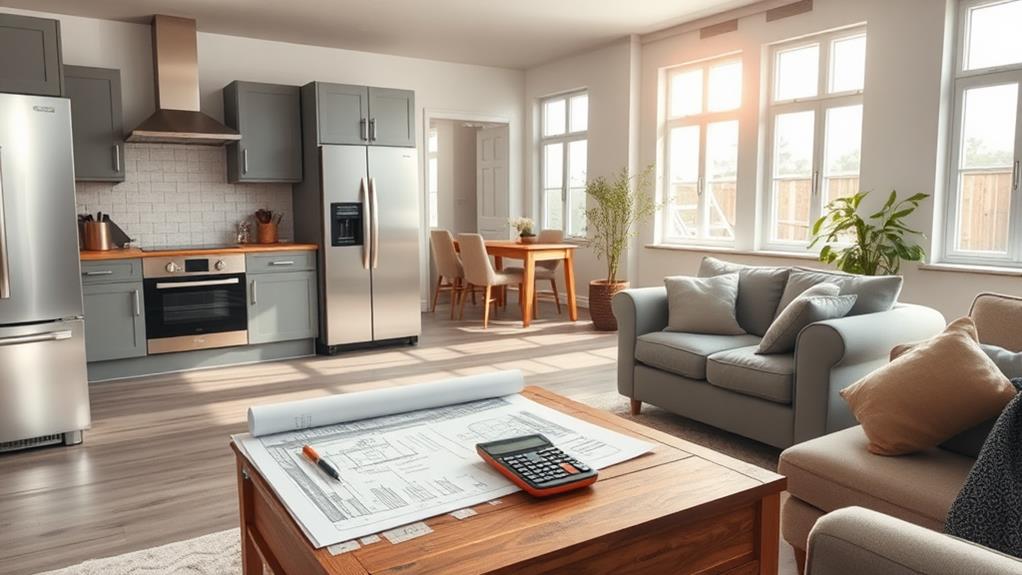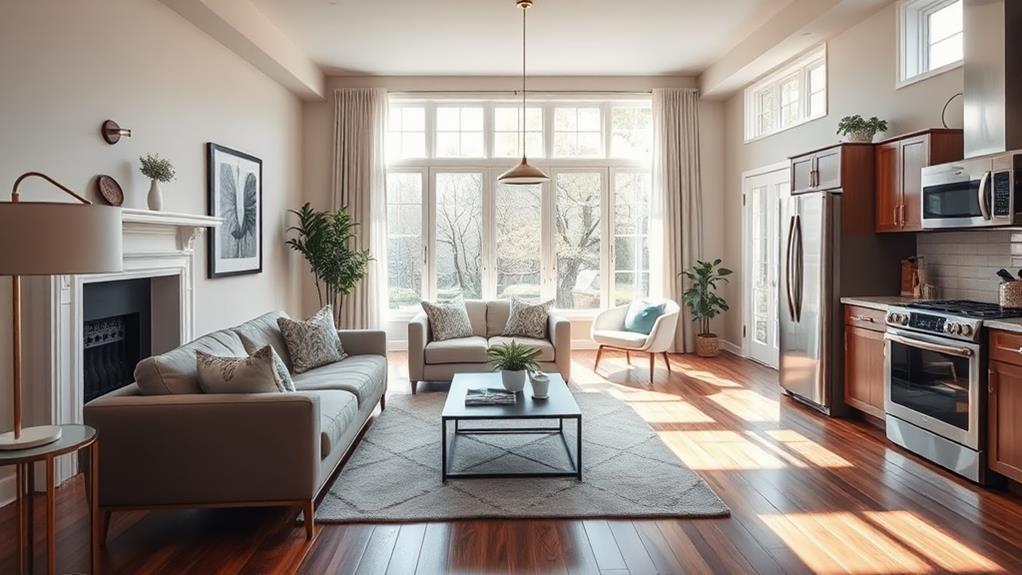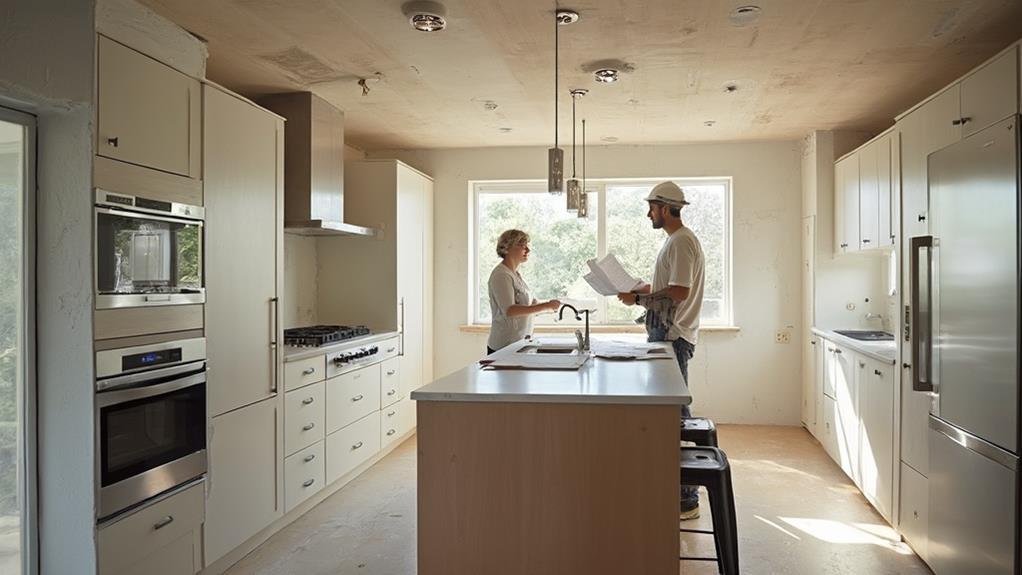Balancing quality and cost in home renovations requires careful planning and strategic decision-making. Start by prioritizing your renovation goals, focusing on essential improvements and energy-efficient upgrades. Research materials and alternatives to find cost-effective options without compromising quality. Obtain multiple contractor quotes and consider combining DIY efforts with professional help for critical aspects. Budget for unexpected costs and time your project wisely to capitalize on off-peak seasons. Reuse and repurpose materials where possible, and consider long-term value when making choices. By following these principles, you can achieve a successful renovation that enhances your living space without breaking the bank. Discover more ways to make smart renovation choices and maximize your investment.
Prioritize Your Renovation Goals

When embarking on a home renovation project, one's first step should be to prioritize renovation goals. This crucial process involves evaluating your needs, desires, and budget constraints to create a focused plan of action.
Start by listing all desired improvements, then rank them based on importance and urgency. Consider factors such as safety issues, structural integrity, and essential functionality improvements as top priorities.
Next, assess which renovations will add the most value to your home, both in terms of personal enjoyment and potential resale value. Energy-efficient upgrades, kitchen and bathroom remodels, and additional living space often yield high returns on investment. Balance these with purely aesthetic changes that enhance your daily living experience.
Research Materials and Alternatives
With renovation goals prioritized, the next step is to thoroughly research materials and alternatives for your project. This process involves investigating various options for each aspect of your renovation, comparing their quality, durability, aesthetics, and cost-effectiveness. Start by exploring traditional materials alongside innovative alternatives that may offer improved performance or value.
Consult multiple sources, including home improvement stores, online retailers, manufacturer websites, and professional contractor recommendations. Pay attention to product specifications, warranty information, and user reviews to gauge long-term reliability. Consider factors such as maintenance requirements, energy efficiency, and environmental impact when evaluating options.
Don't hesitate to request samples or visit showrooms to examine materials firsthand. This hands-on approach can provide valuable insights into texture, color, and overall quality that may not be apparent from online research alone. Additionally, explore reclaimed or recycled materials as potential cost-saving alternatives that can add unique character to your renovation.
Get Multiple Contractor Quotes

Reaching out to multiple contractors for quotes is a crucial step in the renovation process. It allows homeowners to compare prices, expertise, and proposed timelines for their project. Aim to obtain at least three quotes from reputable contractors to ensure a fair assessment of market rates and services.
When requesting quotes, provide detailed information about your renovation plans, including specific materials, design preferences, and any unique requirements. This clarity helps contractors provide more accurate estimates and reduces the likelihood of unexpected costs later.
Pay attention to the breakdown of costs in each quote, noting any significant discrepancies between contractors. While price is important, it shouldn't be the sole deciding factor. Consider the contractor's experience, references, and communication style. A slightly higher quote from a well-established contractor might offer better value in terms of quality and reliability.
Don't hesitate to ask questions about the quotes and negotiate terms. Discuss potential cost-saving measures without compromising quality. Remember that a thorough vetting process at this stage can prevent costly mistakes and ensure a smoother renovation experience overall.
DIY vs. Professional Help
After obtaining quotes from professionals, homeowners face a critical decision: whether to tackle the renovation themselves or hire experts. This choice can significantly impact both the cost and quality of the project. DIY renovations often appeal due to potential cost savings and the satisfaction of personal accomplishment. However, they require substantial time, skill, and effort.
Professional help ensures expertise, efficiency, and typically guarantees the work. Contractors possess specialized knowledge, proper tools, and insurance coverage. They can navigate complex building codes and permits, potentially avoiding costly mistakes. However, their services come at a premium.
The decision depends on various factors: project complexity, homeowner's skill level, available time, and budget constraints. Simple tasks like painting or minor repairs may be suitable for DIY, while structural changes, electrical work, or plumbing modifications often necessitate professional intervention. Homeowners should honestly assess their capabilities and consider the long-term implications of their choice. A poorly executed DIY project may lead to future repairs or decreased home value, negating initial savings. Conversely, strategically combining DIY efforts with professional help for critical aspects can optimize both quality and cost-effectiveness in renovations.
Budget for Unexpected Costs

A prudent approach to renovation planning involves setting aside a substantial contingency fund for unexpected costs. Industry experts typically recommend allocating 10-20% of the total project budget for unforeseen expenses. This buffer helps mitigate financial stress and ensures project continuity when surprises arise.
Common unexpected costs include structural issues discovered during demolition, such as water damage, mold, or outdated wiring. These hidden problems often require immediate attention and can significantly impact the project timeline and budget. Additionally, material price fluctuations, shipping delays, or sudden unavailability of specific items may necessitate last-minute substitutions or design changes.
To minimize unexpected costs, conduct thorough pre-renovation inspections and research. Obtain detailed quotes from contractors, including potential scenarios for additional work. Consider opting for a fixed-price contract to shift some risk to the contractor. Prioritize essential renovations and create a list of "nice-to-have" items that can be cut if necessary. Regularly review the budget throughout the project, adjusting as needed to maintain financial control. By anticipating and preparing for unexpected costs, homeowners can navigate renovation challenges more effectively and achieve their desired outcomes within reasonable financial parameters.
Timing Your Renovation Project
Selecting the optimal time to undertake a renovation project can significantly impact its success, cost-effectiveness, and overall convenience. Consider seasonal factors when planning your renovation. Winter months often see lower demand for contractors, potentially resulting in better pricing and increased availability. However, certain outdoor projects may be challenging during colder weather.
Spring and fall are popular renovation seasons due to moderate temperatures, but this increased demand may lead to higher costs and longer wait times. Summer can be ideal for major projects, especially those requiring good ventilation or outdoor work, but it's also peak season for many contractors.
Align your renovation with your personal schedule and life events. Avoid renovating during major holidays or when you're hosting important gatherings. If possible, plan renovations during periods when you can temporarily relocate or when disruptions to your daily routine will be minimal.
Consider economic factors as well. During economic downturns, you may find more competitive pricing from contractors eager for work. Conversely, during construction booms, prices may increase, and skilled labor may be scarcer.
Energy-Efficient Upgrades

Energy-efficient upgrades represent a crucial aspect of modern renovation projects, offering both environmental benefits and long-term cost savings. Homeowners can prioritize several key areas to maximize their energy efficiency.
Upgrading insulation in walls, attics, and crawl spaces significantly reduces heat loss and gain, lowering heating and cooling costs. Installing energy-efficient windows and doors further enhances thermal performance.
Replacing outdated HVAC systems with high-efficiency models can dramatically reduce energy consumption. Smart thermostats allow for precise temperature control and scheduling, optimizing comfort and efficiency.
LED lighting fixtures and bulbs consume less electricity and last longer than traditional options. Energy Star-certified appliances, including refrigerators, dishwashers, and washing machines, use less water and electricity.
Water-saving fixtures, such as low-flow showerheads and dual-flush toilets, reduce water consumption without sacrificing performance. Solar panel installation, while initially costly, can provide substantial long-term savings and even generate excess electricity.
Lastly, implementing a home energy management system allows homeowners to monitor and control their energy usage, identifying areas for further improvement. By strategically incorporating these upgrades, renovators can create more sustainable, cost-effective living spaces.
Reuse and Repurpose
Reuse and repurposing strategies offer environmentally conscious and budget-friendly alternatives to traditional renovation approaches. By salvaging and reimagining existing materials, homeowners can reduce waste, lower costs, and infuse their spaces with unique character. This practice not only conserves resources but also preserves the history and charm of older elements within a home.
Consider repurposing old doors as headboards, transforming vintage suitcases into shelving units, or converting antique dressers into bathroom vanities. Reclaimed wood can be used for flooring, accent walls, or custom furniture pieces. Outdated kitchen cabinets can be refaced or repainted, breathing new life into the space without a complete overhaul. Even small items like doorknobs, light fixtures, and hardware can be cleaned, refinished, and reused to maintain a cohesive design aesthetic.
When sourcing materials, explore architectural salvage yards, thrift stores, and online marketplaces for pre-owned items. Engage with local artisans who specialize in upcycling to create custom pieces from reclaimed materials. By embracing reuse and repurposing, homeowners can achieve a distinctive, eco-friendly renovation that balances quality and cost-effectiveness.
Long-Term Value Considerations

When embarking on a renovation project, it's crucial to consider the long-term value of your choices. Evaluating potential upgrades based on their durability, energy efficiency, and timeless appeal can significantly impact your home's future worth and functionality.
Prioritize investments in high-quality materials and craftsmanship for elements that are difficult or expensive to replace, such as flooring, windows, and structural components. These choices often lead to lower maintenance costs and increased longevity. Energy-efficient upgrades, including improved insulation, modern HVAC systems, and smart home technologies, can result in substantial savings on utility bills over time.
Consider the potential return on investment (ROI) for each renovation decision. While some improvements may not immediately increase your home's value, they can enhance livability and appeal to future buyers. Kitchens and bathrooms typically offer the highest ROI, but don't overlook the importance of curb appeal and overall home functionality.
Lastly, strike a balance between current trends and timeless design. Opt for classic styles in permanent fixtures while incorporating trendy elements through easily changeable décor. This approach ensures your renovation remains relevant and attractive for years to come.
Frequently Asked Questions
How Do I Handle Disputes With Contractors During a Renovation Project?
To handle disputes with contractors during renovations, maintain clear communication, document all agreements in writing, and refer to the contract. If issues persist, consider mediation or seeking legal advice as a last resort.
What Permits Are Typically Required for Home Renovation Projects?
Ah, permits—the bureaucratic unicorns of home renovation! Typically, you'll need building permits for structural changes, electrical work, plumbing modifications, and HVAC installations. Don't forget zoning permits for additions or major alterations. Check with your local building department for specifics.
Can I Live in My Home During a Major Renovation?
Living in your home during a major renovation is possible but challenging. Consider factors like safety, dust control, and access to essential facilities. Some homeowners opt for temporary accommodation, especially during extensive structural work or whole-house renovations.
How Do I Protect My Belongings During a Renovation?
To protect your belongings during a renovation, consider these steps:
- Remove items from the work area
- Use protective coverings for remaining items
- Rent a storage unit if necessary
- Communicate with contractors about valuable or fragile items
What Are the Best Financing Options for Home Renovation Projects?
Popular financing options for home renovations include home equity loans, home equity lines of credit (HELOCs), personal loans, and cash-out refinancing. Government-backed renovation loans like FHA 203(k) and Fannie Mae HomeStyle can also be suitable for extensive projects.
Conclusion
In the relentless pursuit of the perfect renovation, homeowners must navigate a labyrinth of decisions that can make or break their dream project. By adhering to an almost fanatical level of planning, research, and strategic decision-making, it becomes possible to achieve a renovation that is nothing short of miraculous—balancing jaw-dropping quality with astonishingly reasonable costs. The key lies in an unwavering commitment to prioritization, relentless bargain-hunting, and an almost superhuman ability to foresee and mitigate potential pitfalls, ensuring a transformation that will leave neighbors green with envy.

